 Bengal cats are the ‘wild’ cats of domestic cats. They’re high energy, playful large cats who aren’t easily entertained.
Bengal cats are the ‘wild’ cats of domestic cats. They’re high energy, playful large cats who aren’t easily entertained.
For this reason, many behaviors that you might think of as ‘bad’ can be your Bengal’s natural instincts. So before you get too frustrated with your sweet kitty, let’s talk about some good ways to handle serious Bengal cat behavior problems!
First, we’re going to discuss what your Bengal should be like then point out a few common reasons why she or he might be acting a little bit out of character. Then I’ll be sharing tools that you can use to, hopefully, bring some peace to your space.
Now let’s get a little or a lot more familiar with this exotic pet. 🙂
What Is The History of Bengal Cats?
Bengal cats are the result of the cross between a domestic cat and an Asian leopard. Records of this cross date back as far as the late 1800s but they did not begin to gain popularity until much later.
In the 1970s, Dr. Willard Centerwall of Loyola University was trying to breed cats that were immune to feline leukemia. Asian leopards have partial immunity to the disease so he began crossing them with domestic cats.
He was never able to create such a cat, however, it so happened that a breeder by the name of Jean Mill was also interested in the same cross. So instead of destroying the cats after the experiment was over, Dr. Centerwall gave the cats to Miss Mills even though they were sterile.
Miss Mills later found that it was only the males that were sterile and the females were still able to breed. Once she was able to find a male, spotted, domestic cat, she bred him with the females.
After selectively breeding the cats over the years with other breeders, the Bengal was recognized as its own breed starting in the 1980s. Its name is derived from the scientific name for the Asian leopard which is Prionailurus bengalensis.
The Bengal cat breed was further used to create another breed of cat called the Toyger which is the result of the crossing of Bengal cats and domestic shorthair cats.
Another cat breed related to the crossing with Asian leopard cats is the Egyptian Maus.
Bengal Cats Personality Traits & Temperament
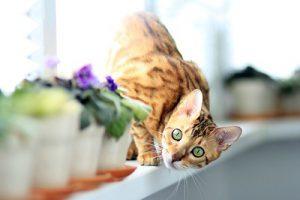 If you are the average cat owner, you should make sure that your Bengal cat is at least 3 generations removed from the original Asian wildcat. This will make them more domestic and less wild. It is highly recommended that you obtain a generation 4 Bengal.
If you are the average cat owner, you should make sure that your Bengal cat is at least 3 generations removed from the original Asian wildcat. This will make them more domestic and less wild. It is highly recommended that you obtain a generation 4 Bengal.
They are fairly large cats. Males can reach up to 15 lbs and females can reach up to 12 lbs.
Their bodies are very muscular, especially their hindquarters. Because of this, they are very powerful jumpers who are able to jump well over 4 feet.
They love to jump and climb over any surface they can possibly reach. Keeping them entertained is no easy feat.
Bengal cats are highly intelligent, affectionate and highly trainable. They are commonly referenced as being ‘dog-like’ because they love to play fetch, go for walks on a leash and will follow you around everywhere you go.
When raised from kittens correctly, they are both child and dog-friendly. Unlike most cats, the Bengal loves water and is a highly skilled hunter. It is recommended that you do not leave Bengals with other pets like fish, rodents or anything they might deem as prey.
Like most cats, if you want to have other cats in the house its best to start with two. This is especially important with Bengal cats because they are very territorial and will not share if they don’t have to from the start.
They also do not do well changing environments but that just means that if you do, you just have to work with them a little extra to get settled in.
Since they are very intelligent, Bengals get bored easily so if you can’t spend a lot of time with them it’s highly advisable to get two Bengals so that they can entertain each other. But you should also know that they are very smart cats and well know for getting into cabinets, drawers, high places, and stealing things that they find interesting.
They are very cunning cats. Some say even moreso than the famed Siamese cats which are pretty tricky cats.
Bengal kittens are also known to be very destructive. In general, Bengals are for experienced cat owners and should only be acquired from responsible, registered breeders since the way they are raised is very important to their success as house cats.
List of the Bengal Cats Personality Traits & Temperament
- affectionate
- energetic
- highly intelligent and capable of solving complex puzzles
- highly trainable
- social and very vocal
- good with dogs and kids if exposed to them early as kittens
- loves the water
- athletic
- loyal
- muscular build
- playful
Causes of Serious Bengal Cat Behavior Problems
Now that you know more about the Bengal cat you can see how some behaviors can easily be mistaken for ‘bad’ behaviors but are just part of this breed’s natural being. For instance, maybe your Bengal might keep jumping on your TV stand and knock things over or get into your kitchen cabinets.
In these cases, your cat is being itself. At the same time though, you probably don’t want him/her in your kitchen cabinets or they may have broken something really valuable so its no consultation to leave it there.
Before we come up with a solution, let’s discuss their bad behavior in more details.
Serious Bengal Cat Behavior Problems Due To Illness
Whenever your pet is acting out of character, the first place to look is their health. Just like you don’t feel yourself when you’re sick, neither will they.
If you suspect that your cat is sick, injured or in some sort of discomfort, take him/her to see your vet right away.
Some signs of illness may be:
- diarrhea
- vomiting
- loss of appetite
- loss of activity
- increase in aggression
- hiding out more often than usual
- making painful noises
- labored breathing
- mucus in eyes and/or nose
- bloody stools
- changes in mood
- increased urination
- struggling to urinate
- etc.
Although Bengals are known to be healthy cats, there are some diseases that they commonly contract that you should be aware of. Make sure to mention them when you go to their vet appointment because some require extensive testing to diagnose and only the vet is able to do that.
Hypertrophic Cardiomyopathy (HCM)
Hypertrophic Cardiomyopathy is a condition that creates the abnormal thickening of the muscles of the heart’s walls. It is known as the ‘silent killer’ because it is so hard to detect.
It is genetically inherited but can go generations without showing due to its ability to be both a dominant and recessive trait.
If your cat has this disease, it is usually detected during auscultation of a physical exam. It can only be diagnosed with radiographs or an echocardiogram.
Progressive Retinal Atrophy and Cataracts
Since both of these conditions are inherited, you can decrease your cat’s chances of developing them by verifying the breeder you got them from screened their parents for them.
Progressive Retinal Atrophy is the degeneration of your cat’s photoreceptors in their eyes. Cataracts are the clouding of the eyes which you can detect visually.
Both conditions can lead to impaired vision and blindness.
Anesthetic Allergies
Anesthetic agents are drugs used to relax the body and reduce pain. They are commonly used during and after surgeries.
If your cat has this allergy you can find specialized locations equipped to perform surgeries on your cat.
Luxating Patellas
The patella is another word for the ball part of the knee. What happens in this condition is that the knee ball is dislocated.
This can cause your cat to struggle with walking and may lead to other conditions like degenerative arthritis.
Kidney Disease and Renal Failure
As a species, cats are prone to kidney issues especially as they age. The risk of issues developing is increased if your cat has already had stones or another type of kidney infection.
A sign that your cat might be having kidney issues is if you notice an increase in urination.
Problems with their Skin and Coat
Psychogenic alopecia is a condition where the cat overgrooms itself. It is usually associated with some sort of stressor like boredom, change of environment, etc.
Hair loss can occur with this condition as a result of allergies to fleas, food, their environment, etc.
Again, if you suspect that your cat is struggling in any way, take him/her to the vet.
Serious Bengal Cat Behavior Problems Due To Boredom
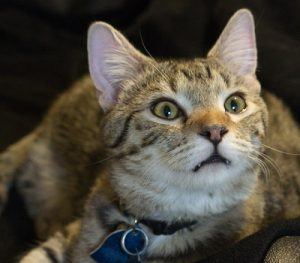 Since Bengal cats are very intelligent, they need to have toys that keep their brain engaged or they will tire from it easily. Of course, even if it is a difficult puzzle, your Bengal will likely still get tired of it at some point.
Since Bengal cats are very intelligent, they need to have toys that keep their brain engaged or they will tire from it easily. Of course, even if it is a difficult puzzle, your Bengal will likely still get tired of it at some point.
This cat is very hard to keep entertained and will constantly look for new activities. They also have a strong need to climb.
If you can not provide them with both, they will tear your house down to find it. Bored cats can also be quite destructive, aggressive and/or on edge because they are unable to release their energy.
Boredom can also lead to psychological problems like anxiety, depression, psychogenic alpenacia, etc.
Bad Behavior Associated with Territory Struggles
Bengal cats are highly territorial, especially if they were originally by themselves. It is recommended that if you plan on having more cats in your home with your Bengal that you get two right off the bat.
This goes for both males and females whether they are fixed or not. Of course, decreased testosterone will make a male cat less aggressive but cats will always have a territory for hunting reasons.
Your Cat Is Bad Because It Can’t Engage In Nature
In general, cats have a strong need to be outdoors. For Bengal cats, this need is even more heightened.
It wants to be outdoors engaging with nature. By this I mean s/he wants to:
- be in the fresh air
- soak up the sun
- sniff around
- hunt (of course you’re not going to actually let it though)
- roam (around your yard)
- and get into just about anything it can sink its paws into
Be aware though, that you can NOT let your Bengal cat free roam. It is very dangerous for the cat but the environment as well.
I’ll be talking about solutions soon so please keep reading. I don’t want to get off topic 🙂
Unexpected Changes Bring About Unexpected Behaviors
The Bengal cat does not do well to change. For this reason, if you move homes or have a baby or some other change happens in your household, it would be wise to take some extra time to help your Bengal adjust.
You can imagine how changes you don’t like make you feel.
- irritable
- lonely
- scared
- longing
- etc.
Your Bengal is feeling a lot of these too and probably even more that it can’t verbally explain even though it might try.
Being Raised By Irresponsible or Inexperienced Breeders
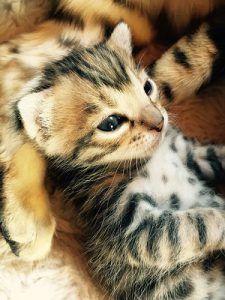 A lot of times when people get things wrong about pet care, others turn into crazy, bashing machines. If your cat was raised incorrectly, please don’t auto-bash the breeder.
A lot of times when people get things wrong about pet care, others turn into crazy, bashing machines. If your cat was raised incorrectly, please don’t auto-bash the breeder.
S/He may be irresponsible but they may also be inexperienced. In reality, everyone has to start somewhere and at some point every breeder was inexperienced.
That being said, there are a couple of things your Bengal needed to learn as a kitten in order to be able to fit into the domestic lifestyle. Some of these things are:
- bite inhibition and that hands are not toys
- being adjusted to children
- being adjusted to dogs
- resisting the urge to hunt in your fish tank or bird aviary
- proper interaction with people
If your cat has not learned these important skills, his or her ‘bad’ behavior may be very difficult to reverse.
Solutions for Serious Bengal Cat Behavior Problems
I think the easiest one of the list to find an immediate plan of action for is an illness. I also should have added injury to the section.
If you suspect anything is ailing your Bengal’s health and physical well-being in any way, take him/her to the vet immediately. They will also be able to refer you to specialists if need be including those for certain body conditions but also for behavioral help.
Giving up your cat or any pet is never an option in my book. Ever.
Boredom & Territory
Though these two issues are very different, their solutions are pretty similar. So I’m combining to spare you from having to read the same thing twice, lol.
The good thing about cats is that their territory can be expended horizontally. This works two-fold with Bengal cats because it also gives them a better place to stretch their limbs than atop your cabinets and high appliances.
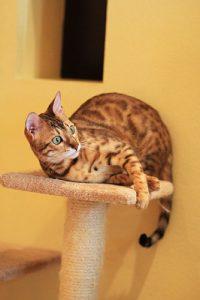 To do this, all you need to do is get a bunch of DIFFERENT cat trees and furniture in your home. The important part here is that you get the good ones.
To do this, all you need to do is get a bunch of DIFFERENT cat trees and furniture in your home. The important part here is that you get the good ones.
Yes, you’re going to have to spend some money but it will be money well spent. You will also need to use a combination of wall-mounted and free-standing cat trees.
If you have to choose one, go with wall-mounted cat trees. They will give your cat everything it can get from a free-standing one and you can get the highest with them.
If you are looking for good recommendations for the best cat trees for Bengal cats, click the button below for more info.
Click Here To Learn More About The Best Cat Treess for Bengal Cats!But of course, since we are talking about the craftiest cat breed, we’re going to need some additional help. The next thing you will need to build up is toys.
Like the cat furniture, not just any toys will do either. You will need sturdy cat toys that are puzzles or have some element of figuring out how to use them.
They may even prefer children’s toys as opposed to cat toys. You know the ones where you have to pull out the right shapes or something like that.
Another good toy for them is treat toys that make them think about how to get the treat out. Just be sure to secure the opening mechanism so they don’t cheat!
Helping Your Cat To Adjust to Knew Changes
Its always tough to adjust to changes in your home. If you’re expecting a new child or pet, try to get your Bengal cat used to whichever before their actual arrival.
You can do this by getting a crying doll baby or barking dog toy.
If you are moving to a new location, try to get your cat used to the new area first. Even if it is far away, get your Bengal used to some of the smells and sites that it might encounter.
For instance, if you’re moving close to a beach, get your Bengal used to the salt water smell. If you are moving to an apartment, get it used to indoor plants and take it for walks.
If your cat becomes too stressed, try some kitty aromatherapy. You can find tons of information by doing a quick Google search.
If all else fails, try to seek assistance from a cat behaviorist in your area. They will be best equipped to advise you on what your next steps may be.
The most important part is understanding your cat’s situation. You will probably have your own feelings too and that’s ok. Realize that your cat will as well.
Giving Your Cat Room To Engage With Nature
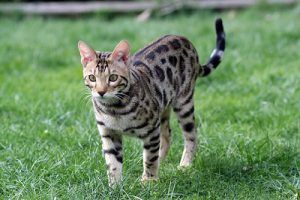 Engaging with nature is an important part of cat culture. That’s why the spend a lot of time near windows and might even howl the door down to be let outside (which you should not do without supervision).
Engaging with nature is an important part of cat culture. That’s why the spend a lot of time near windows and might even howl the door down to be let outside (which you should not do without supervision).
The good thing about Bengals is that they will follow you. They will also walk on a leash.
Take some time out of your day to take your Bengal cat outside. Do not let him/her go outside alone if you really don’t have time.
Summer is a little easier than winter because the days are longer. If you really can’t spend the time taking him/her outside, try getting an outdoor cat enclosure installed on your home.
Make sure that the screen part is cat-proof. You can have these custom made too and bigger is better when it comes to Bengal cats.
If you’re looking for more info on outdoor cat enclosures, click the button below.
Click Here To Learn More About Outdoor Cat Enclosures!That’s all I have for you on this subject. I hope that you have found it informative and helpful. If you have your own tips, please feel free to share them.
And of course, if you have any questions, please also ask them in the comments box below.
The important thing here is to be open to your Bengal cat’s personality and traits. It is a high energy, wild child that loves to play.
When you feed his/her instincts, you will create a more stable environment within your home. So to recap:
- First of all, make sure nothing is ailing your cat by getting him/her/them examined at the vet and cat behaviorist experienced with Bengal cats.
- Then in addition to their recommendations, install a variety of good cat trees for Bengal cats. Wall-mounted cat trees are a must with Bengal cats.
- Next add some TLC to your Bengal’s life. Give it some space of its own (like cat trees) and take it outside for parts of the day.
Your Bengal cat is likely not a bad cat at all. With a little patience and work, I’m sure you can get some control over your home.
Click the button below to read more about the best cat trees for Bengals and I’ll talk to you soon! Bye!
Click here to read more about cat trees for Bengal cats!


This is so great, I didn’t know anything about Bengal Cats, really makes me want one! I guess these behavioural issues can be with non-Bengal cats too.
I came across your excellent site while researching why our cat was meowing in the middle of the night… turns out we think there’s an outdoor cat on heat nearby!
Thanks for the useful info, I’ll be looking at the cat scratching posts soon!